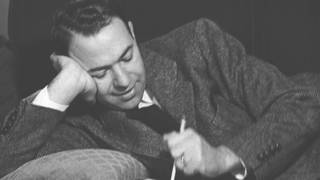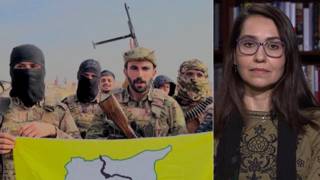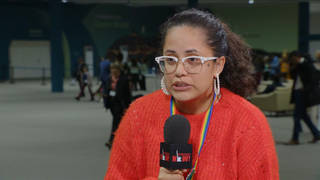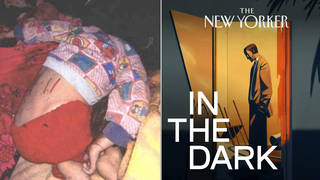
Related
Topics
Images of thousands of dead U.S. soldiers helped to turn the tide of public opinion against the Vietnam War, but now photo-journalists are even banned from military funerals at Arlington national cemetery. A report this weekend in the Los Angeles Times documented the extremely rare publication of photos of American casualties in six major newspapers during a sixth month period. Readers of the Atlanta Journal-Constitution, Los Angeles Times, New York Times, St. Louis Post-Dispatch and Washington Post never saw a single picture of a dead serviceman or servicewoman in their morning papers. [includes rush transcript]
Violence continues in Iraq on a daily basis. A car bomb in central Baghdad killed at least nine Iraqis on Tuesday. Meanwhile the death toll from a string of attacks on Monday has risen to at least 54. Over 130 people were wounded. Over 600 Iraqis have been killed in just over a month.
The latest attacks came as American and Iraqi forces are conducting a joint offensive in Baghdad. The US military announced that over 420 people were arrested in just over 30 hours during the sweep dubbed “Operation Squeeze Play.”
Five US troops have also been killed in the past two days. But Americans almost never see photographs from Iraq showing U.S. troops killed in action. Images of thousands of dead U.S. soldiers helped to turn the tide of public opinion against the Vietnam War, but now photo-journalists are even banned from military funerals at Arlington national cemetery. A report this weekend in the Los Angeles Times documented the extremely rare publication of photos of American casualties in six major newspapers during a sixth month period. Readers of the Atlanta Journal-Constitution, Los Angeles Times, New York Times, St. Louis Post-Dispatch and Washington Post never saw a single picture of a dead serviceman in their morning papers.
We’re joined on the phone by L.A. Times reporter James Rainey who wrote the story. And in the studio we are joined by veteran journalist Sidney Schanberg, now the media columnist for the Village Voice. Schanberg has covered wars in India, Vietnam and Cambodia and won a Pulitzer prize in 1976 for his reporting on the rise of the Kmer Rouge and dictator Pol Pot in Cambodia. Last week, he wrote a piece in the Village Voice calling on journalists not to omit important information and images out of “timidity or squeamishness.” He writes that the reason governments seek to censor and sanitize wartime coverage is “to prevent a public outcry against the war, an outcry that might bring down the administration.” We are also joined by Pacifica Radio reporter Aaron Glantz. He spent months covering the occupation of Iraq and is author of the new book “How America Lost Iraq.”
- James Rainey, reporter at the Los Angeles Times, author of the report, “Unseen Pictures, Untold Stories” published on Saturday in the Times
- Sidney Schanberg, veteran journalist formerly at the New York Times and Newsday. Won a Pulitzer Prize in 1976 for reporting on the rise of the Kmer Rouge in Cambodia.
- Aaron Glantz, reporter for Pacifica Radio. He spent months covering the occupation of Iraq and is author of the new book “How America Lost Iraq.”
Transcript
AMY GOODMAN: We are joined on the phone by Los Angeles Times reporter, James Rainey, who wrote the story. In the studio with us, veteran journalist, Sidney Schanberg, Pulitzer Prize-winning reporter from Vietnam, now media columnist for The Village Voice. Schanberg has covered wars in India, Vietnam, Cambodia. We are also joined by Aaron Glantz. He is a Pacifica reporter who wrote the book, How America Lost Iraq. We welcome you all to Democracy Now! I want to begin with the L.A. Times reporter, James Rainey. Tell us what you found, the actual count on these pictures?
JAMES RAINEY: Well, what we did is we started in September of last year and went through the end of February of this year. We wanted a manageable period, because that’s a lot of newspapers to look at. We also wanted to take in some of the major fighting, which was the assault on Fallujah last November, and then the run-up to the election, which I think everybody remembers was pretty bloody. So, we looked at the six newspapers and we looked at Time and Newsweek, and what we found is what you already stated, essentially, that the readers of those publications didn’t see any U.S. dead. They saw very few pictures of U.S. wounded. There was one of the eight publications we looked at, The Seattle Times did run a picture of a U.S. serviceman who was killed. He was covered with a blanket. It was after the mess hall bombing last December near Mosul. So that was — those were our findings in terms of U.S. casualties. Very few pictures.
AMY GOODMAN: Sidney Schanberg, you certainly covered the Vietnam War and your colleagues did by bringing home the images, whether in description or photo. Can you talk about this? You also write extensively about this in The Village Voice.
SIDNEY SCHANBERG: Well, I think I can tell you that American reporters have always been careful not to show, certainly not to show the face, identifiable face of a fallen soldier who is dead, and still do that. And that’s — I think that’s a useful guide, a taste guide in terms of whether you are going to over-shock people or not. But we always showed pictures of fallen soldiers in Vietnam, and we, as Jim Rainey points out, we see almost none of them in the Iraq war. This censorship has been going on for a long time. I mean, if we go back to the Gulf War, you remember, reporters had to be taken by babysitters, Pentagon babysitters, to stories, and the soldiers that they met on these stories had been pre-interviewed by the same babysitters, so that no truth might slip out during the interviews with the journalist. So —- and we acceded, the major news organizations acceded to those ground rules. And -—
AMY GOODMAN: I want to point out that Pacifica, along with independent publications, sued the Pentagon over the press restrictions during the Gulf War. We couldn’t get the major newspapers to join us.
SIDNEY SCHANBERG: I was one of the plaintiffs.
AMY GOODMAN: You were with us. And we couldn’t get one of the newspapers not only to join us, but to cover the lawsuit?
SIDNEY SCHANBERG: That’s correct. Yes. I mean, that is — well, they were — and embarrassed as a result of all of that, they decided to try to negotiate for a different situation in the next American combat, and they did, and we had embedded reporters, which is a good thing because it gives you a piece that we should see, that is, the soldiers as they live during combat. And — but it’s, of course, not the full picture. And the only way you get the full picture is if you are on your own and you are functioning unilaterally and outside any particular ground rules, at your own risk.
AMY GOODMAN: What about the power of these pictures, what it meant to show this during Vietnam? I was wondering if you could just briefly for listeners and viewers who aren’t familiar with your own story, Sidney Schanberg, the film Killing Fields was very much about what you did, but if you could just briefly summarize.
SIDNEY SCHANBERG: Well, I think the pictures played a large role. I don’t know how much because I was in Southeast Asia, so the truth is that someone back here in the United States can speak to how powerful they were in affecting public opinion. But from my point of view, the pictures are terribly important, and that is that if this is going to be a free press democracy, that you — the press operates as a voice for the or a window for the public, and the public has a right to know just how bestial and horrible war is. And that’s what we’re there for, to tell people what’s going on, and what it feels like and looks like and smells like where war is happening. And by not informing people, we make them — we infantilize them so that they are shocked when they hear there’s torture, and they are shocked when something terrible happens that does get covered, and let’s say the government has no control over. And so, it’s just terribly important when we are making decisions to go to war, that the voters, the citizenry and everybody knows what war is like before you step into it. Because it is — it should be a last resort, and in this case, in Iraq, it was not.
AMY GOODMAN: You quote a photojournalist at the end of your piece.
SIDNEY SCHANBERG: David Leeson, whose pictures were shown with my piece.
AMY GOODMAN: Talk about what he said.
SIDNEY SCHANBERG: Well, he said — David is very impassioned, and he is a terrific journalist and person. He said — he — the way he felt when he was working in Iraq was that “if I am hurting inside, then I want you,” that means the reader, the viewer, the audience, “I want you to hurt inside. And if I am brought to tears, I want you to be brought to tears, too.” That’s exactly how one feels. I mean, that’s how I felt. You feel a bit like you are throwing a tantrum, like you are saying, “Pay attention! Pay attention! People are dying here!”
AMY GOODMAN: James Rainey, in this piece, “Unseen Pictures, Untold Stories,” in The Los Angeles Times, U.S. newspapers and magazine print few photos of American dead and wounded. The reasons are many, but the result is an obscured view of the cost of war. You actually interview some of those who make these decisions not to show these pictures. Can you talk about those conversations?
JAMES RAINEY: Yeah. First of all, I’d like to say, though, one of the major reasons that we’re not seeing these pictures of the American dead is the photographers just aren’t getting them. And some of that has to do with the actions of the government. A lot of it has to do with straight logistics. We’re talking about a huge country. We’re talking at any one time as few as three embedded journalists, and then others who, as Sidney said, are free to roam the country, there aren’t many of them right now who want to do that, because this is probably the most dangerous conflict that any of these folks have ever covered. That’s what they told me. So, many of the decisions aren’t even made back here in the United States. There’s no decision to be made, in essence, because the picture is never taken. The humvee gets blown up by a roadside. You know, there are six or seven G.I.s or marines killed, and they’re shipped off to hospitals very quickly. The photographers often don’t get there until it’s all over.
Something else I just want to say about the historic part of this, I think it is hard to tell unless you were there what the effect of the photos in Vietnam was, but I interviewed David Halberstam about this and, of course, won a Pulitzer Prize for his coverage of Vietnam, and he felt that, yes, the photographs had played an important role, but that really the American public sort of led in that regard, and that it was only after the Tet Offensive and all the losses on the American side in that war, that it then became maybe more acceptable for the press to run critical photos. There certainly had been some before 1968, but — so, I think it’s sort of questionable — questionable about how much the press led even in Vietnam, where certainly some great work was done by journalists, by photojournalists.
In terms of the current conflict, I mean, what we found out was that there’s a lot of reasons, and one of them is just that American editors are very loathe to show pictures of graphic violence. They just don’t show pictures, even if it’s a traffic accident across town, they tend not to want to show them. If you are in Europe or if you are in Latin America, you will see those pictures quite commonly. And then, I think there is a considerable pressure from, if not directly, indirectly from the military and certainly from the families of the soldiers and the marines to not have a lot of these photos in the paper.
AMY GOODMAN: Of course, there’s — yes, Sidney Schanberg.
SIDNEY SCHANBERG: Well, first of all, Jim is right about the danger in Iraq. It probably is — it clearly is much more serious than in Vietnam because of the nature of that and this insurgency. But the truth is that you don’t come across these pictures unless you are actually at the scene, but the larger truth is that there are pictures because other people take them, and if the editors wanted them, people — journalists in Iraq and in the region would be trying to find pictures from local sources, someone with their own camera. And they would be bought and shown, and secondly, the families, I think, are the least of it because in most of these photos, the face is not shown, and the name does not have to be used. It is simply a soldier. And if the name isn’t used, then — and no one can identify the soldier, so then it isn’t really a problem.
The problem is the fear, I believe, that editors have of being called unpatriotic in a wartime situation. And the government uses that fear to further intimidate. And I think this is how it happens. I don’t think it happens because photographers and journalists at the scene aren’t interested in pictures. I think that would — I mean, that’s foolish to say that, and pictures are important. So, you just have — you have to get newspapers and television stations, their editors and their proprietors to say, yes, we’re going to show these things.
AMY GOODMAN: I wanted to move to an example of terrible pain and agony, Fallujah, and how little we saw. Recently, I was listening to Richard Clarke, author of Against All Enemies, who was the counterterrorism czar saying, “Fallujah, Fallujah, if we saw those pictures.” And it’s not just about pictures, it’s word pictures, too. Reporters can describe. Aaron Glantz. You went to Fallujah. You reported for us and for Pacifica Radio about the people on the ground, and not just talking U.S. soldiers, Iraqis as well. We rarely see their pain. Can you talk about that? I’d like to even play a clip of one of your reports.
AARON GLANTZ: I was in Iraq in April and May of 2004 when the United States military was bombarding Fallujah. This is very typical, actually, under the occupation that there will be some, you know — I mean, smaller crime against U.S. people like this killing of these four Blackwater Security figures and their hanging on the old Fallujah bridge. And it will bring a tremendous response by the U.S. military and the killing of hundreds of people is what happened in Fallujah. I was in Baghdad at that time and, at first, I thought it was unsafe to go to Fallujah, so I would interview refugees fleeing the city. I interviewed a 12-year-old boy who talked about how a U.S. military sniper shot his 11-year-old best friend, as he stood in front of his school. I interviewed a man who talked about how his father was in his own house and that that house was bombed by the U.S. military. I spoke with so many people. I spoke with a man who had a bullet in his — right below his collar bone because U.S. military snipers in Fallujah were aiming for the neck, and they had just barely missed as he went to go get food aid from a neighborhood mosque.
And I think at some level I thought that these stories that I were hearing were exaggerations, that the situation couldn’t possibly — in fact, even sitting in Baghdad, I thought the situation in Fallujah could not possibly be as bad as these refugees were telling me, even as Al Jazeera was broadcasting from the hospital, showing us images of the women and children in the hospital. But when I went to Fallujah, after the bombing had stopped, I saw that the city had just been devastated. Whole streets had been destroyed. I saw shopping centers that had collapsed, mosques that had been bombed, and the story that sticks out the most for me, is of this woman, and I think this is the clip that we’re going to hear, who was buried in the front lawn of a neighbor’s house because as she was trying to flee the city in her car, the Americans bombed it.
AMY GOODMAN: We’re going to go to that after break. We’re talking to Aaron Glantz, a Pacifica reporter, spent a good deal of time in Iraq and now has a new book, How America Lost Iraq. Sidney Schanberg, a Pulitzer Prize-winning reporter, did a piece in The Village Voice about the pictures that we are not seeing. James Rainey, on the line with us from The Los Angeles Times on that issue, as well, “Unseen Pictures, Untold Stories.”
[break]
AMY GOODMAN: Our guests are James Rainey of The Los Angeles Times; Sidney Schanberg, now writing for The Village Voice, Pulitzer prize-winning reporter, covered Vietnam, Cambodia and other war zones; Aaron Glantz, author of How America Lost Iraq. Let’s turn for a moment to that piece that Aaron did from Fallujah.
AARON GLANTZ: A team of local volunteers in surgical masks lift the rotting corpse of a middle aged woman from a shallow grave in the front yard of a single family home. The owner of the house explains the woman has been lying dead in his front yard for three weeks. He says an American warplane bombed her car as she fled the city with her husband, who is buried in the garden of the house next door. The destroyed remains of the car still smolder a few meters away from his front door. “We couldn’t give her a proper burial,” he says, “because every time we would go outside, American snipers would shoot at us. They even shot at us when we retrieved her carcass from the car after the Americans bombed it.”
The head of the medical team asks to speak anonymously, because his clinic’s ambulance was shot by U.S. Marine snipers twice during the siege. One of the clinic’s volunteers was killed. “The Americans are dogs. They try to kill anybody who works humanitarian aid. They attack humanitarian aid worker, doctor or ambulance to kill them.”
In the meantime, the aid worker says many corpses continue to rot under buildings, which collapse on top of them, amid a hail of American firepower. The volunteers place the woman onto a gurney and take her away in a small pickup truck. In a half an hour, she is buried in the municipal football stadium, alongside 600 others killed in the last month by the U.S. military.
AMY GOODMAN: Aaron Glantz in Fallujah. Your thoughts as you hear the report now back here at home and with the kind of images that we’re getting in the United States.
AARON GLANTZ: One of the images that people who are watching on television just now saw, in addition to this rotting corpse in the front yard, is of the football stadium in Fallujah, which had to be turned into a mass graveyard, and that the whole grass of that football stadium had to be ripped up and replaced with graves. And this is, remember, in May of 2004, and since then America in November, which both Bush and Kerry agreed with, launched another massive bombing campaign where many innocent civilians were also killed.
I came back to America in May of 2004, and I found that people here in this country were not talking about Fallujah. They didn’t know about Fallujah. People knew about the Abu Ghraib prison scandal because of the photos that were played on CBS News and published in The New Yorker magazine, but people had no idea about what happened in Fallujah, and this was the key issue on the ground in Iraq, the mass slaughter of civilians at the hands of U.S. military, all shown on satellite television to everyone throughout the country. And I almost felt I was listening earlier the comment that you just want to purge yourself and you just want to scream, you know, when you are in that situation. And, you know, I would come back and people thought I was somewhat extreme in my own statements and the statements that I played, like “the Americans are dogs” by that doctor, but you know, when you are in the situation, there’s very little else that you can say.
AMY GOODMAN: I wanted to go back to this point of what the media does broadcast or what the media — the images that the print press shows, and ask James Rainey of The Los Angeles Times about your own paper, the comment of Sidney Schanberg, that the images are out there. I mean, we just watch Al Jazeera, we just see the other press around the world. They have got the horrific pictures the U.S. sanitized, as you yourself pointed out. What about The Los Angeles Times?
JAMES RAINEY: Well, I think there’s no doubt that our paper, I mean, that’s what our studies showed, that during that six months there weren’t any U.S. dead shown, and I think there were ten wounded servicemen and women from the U.S., which was the same number The New York Times showed, and that was far and away more than any of the other papers. I guess, if you judge based on these eight publications, the L.A. Times and The New York Times showed a lot, but they were few compared, of course, to the total number of casualties, which was, you know, I think we’re up to 1,700 dead, counting the Western allies and, you know, thousands wounded. So, there were very few pictures.
AMY GOODMAN: Sidney Schanberg.
SIDNEY SCHANBERG: I think part — when we talk about the press, I think we sometimes forget that the role of reporters, reporters both at home and at the scene — at the scene, I think there’s no issue — but reporters sometimes have to speak truth to editors and to push, because it’s — we are not just, you know, mute bystanders. We know that. So, if we think that something isn’t being covered, even if we’re sitting in the newsroom in New York or San Francisco or Los Angeles, we should be saying to the editors, “Why aren’t we running these pictures?” Because the timidity is unacceptable. Yes, you will get complaints from some people saying these pictures are over the top and gory and so forth. That will always be the case, but the pictures are necessary, and we are leaving information out of stories, information in those pictures.
AMY GOODMAN: Aaron Glantz, what about the journalists that do get the images?
AARON GLANTZ: Well, I think there is the coordinated campaign at this time by the U.S. military and to some extent the new Iraqi government to prevent these stories from getting out. Al Jazeera, after broadcasting from the hospital in Fallujah in the May 2004 siege, was kicked out of the country and is still banned from Iraq. And if you watch Al Jazeera today, they will regularly read an announcement urging people to call and complain about the fact that they’re banned from Iraq. An Al Arabiya reporter, who went to Fallujah and was working on a documentary on Fallujah, was arrested by the Iraqi police a few weeks ago and held on bogus charges, and he was released, interestingly, when he gave over his tapes. A CBS News stringer covering the insurgency in Mosul was shot by the U.S. military, and after the military took him to the hospital, they didn’t release him. They found in his camera that he had been filming the resistance, and so they incarcerated him. So, there is something going on on the ground in Iraq to make sure that these images that were broadcast nationally and across the Arab world during the 2004 siege of Fallujah, that radicalized the population so much, that even as we have these mass sweeps, as you were saying today in West Baghdad, with more than 400 Iraqis arrested by the U.S. military, to make sure that people even on the ground in Iraq do not see those images.
AMY GOODMAN: We’re talking to Aaron Glantz, he is with Free Speech Radio News, Pacifica Radio and reported for us as well on Democracy Now!; Sidney Schanberg; and James Rainey of The Los Angeles Times. Your response to that, the dangers that reporters face. And now, campaigns against any of those who talk about the targeting of reporters, you know, about what happened with Eason Jordan, a CNN top executive dared say off the record he thought that reporters were being targeted, and he is out. Now, Linda Foley, the president of the Newspapers Guild, mentioned this at the Media Reform Conference, the targeting of journalists and a campaign to have her ousted.
SIDNEY SCHANBERG: My own feeling and my own experience as the targeting is either non-existent or very rare, because most of my experience is that when you are in the field covering the story, and an American unit is there, that you will be protected by them. They’re going to look after you, even if you are not embedded and even if they know you’re writing things that they don’t agree with.
AMY GOODMAN: Even if you are an Arab reporter?
SIDNEY SCHANBERG: I don’t know that. All I really know is that the idea that they are targeting Western press or American press does not strike me as valid, not from my experience.
AARON GLANTZ: Well, I don’t think they’re attacking American press or Western press, as such, but I think that they’re indiscriminately shooting at people, and so I have had a gun pointed at me in the course of working. I have had a gun pointed at me by American soldiers numerous times and felt that my life was threatened by an American soldier, simply because they were so scared and trigger-happy, but I have never felt unsafe at the hands of an Iraqi fighter, because they know the lay of the land and they understand the situation. Then, in addition to that, as more and more Western journalists are afraid to work in Iraq, and I myself am afraid to work in Baghdad at this point, as more and more Western journalists pull out, the Iraqi journalists who remain and the Pan-Arab journalists who remain are specifically being targeted by the U.S. military, I believe, when they broadcast controversial material, and then you have the parallel track of propaganda by the U.S. military, launching the satellite station Al Hura, broadcasting from Virginia to the Arab world, launching Radio Sawa, the Voice of America in the Middle East, which was started after VOA reporters interviewed Mullah Mohammad Omar. Voice of America Arabic Service was shut down, Radio Sawa was created. So there’s a real propaganda effect in the Arab world to make sure that people do not see these images.
AMY GOODMAN: Let me ask why —
SIDNEY SCHANBERG: I’d just like to throw in one thing.
AMY GOODMAN: Yes.
SIDNEY SCHANBERG: Soldiers are scared in war. That’s the truth. And they will fire at something that moves, and it may be you. And they may fire just out of their fear that something bad is going to happen to them, because they’re under fire. But using the word “targeted” means you point your weapon, you know who you’re —- you know, it implies that you know who you are shooting at, and you’re deliberately firing at an American reporter. As for the -—
AMY GOODMAN: Any reporter.
SIDNEY SCHANBERG: Yeah. As for the Iraqi reporters who are left behind, and Aaron mentioned, yes, I can see the American establishment there, the military establishment trying to suppress any reports that they don’t like and doing more to the Iraqis than they would do to an American. I mean, that is very likely. I mean, the military wants to win the war. They know that if — I mean, to the military, we are annoyances at best. And so that we have to accept that and know that we are going to have to go around that or whatever. Iraqis have less power to do that, but I still would question the word “targeted.”
JAMES RAINEY: Yeah, I have to say something, too, because I talked to many photographers who worked over there, and actually, they, I would say, almost universally admired the American soldiers there. I think the thing we have to be careful is what happened in Vietnam, where decisions are made in Washington, you send these often 19- and 20-year-old kids over there to carry out that mission, and they’re frightened. And they’re doing their best, I think, most of them under very difficult circumstances. I haven’t been in Iraq, but I have interviewed many photographers who have been. They felt a great deal of empathy for the soldiers there. That does not mean they necessarily supported or were opposed to the war. I think there are photographers in both camps. So, I think it’s kind of dangerous to suggest they’re out — at least on the American side — that they’re out there specifically shooting at journalists. That’s not something I studied, so I probably shouldn’t say more.
I wanted to say one other thing, too, about the casualty pictures, which is that there is a considerable difference between the casualty pictures shown of Americans and Iraqis. I think if you read some of the big papers in this country, including The L.A. Times, The New York Times, there have been quite a few photos of Iraqi casualties. And if you read closely and looked closely, there are plenty of images there for you to make up your mind about how you feel about the level of bloodshed. The interesting thing about that is some people see these photos and see reason to be opposed to the war. Some people have seen some of these photos and they see sacrifice, and American sacrifice and Iraqi sacrifice, and there was a survey done of American readers; I included this in my story, and we quote a woman in our story, who sees one of the dead G.I.s and she says, “Yes, I’m glad you ran that picture, and I’m glad you ran it because it doesn’t tell me this is an unjust war. It tells me that, you know, these guys are giving their lives for freedom.”
AMY GOODMAN: Aaron Glantz, your response.
AARON GLANTZ: The photos of Iraqi civilians that you see in the newspaper are invariably tied to a car bombing by insurgents. And the car bombing is not explained. It’s not explained that they’re targeting a U.S. military convoy and that they miss, or they’re targeting the Iraqi police that are seen as collaborators because they engage in these house to house searches and raids and take people to Abu Ghraib. So, the images that you are seeing, you are not getting the back story for them. You are not getting the story that the woman was killed while she was trying to flee the city, and she was bombed by the U.S. military. So, yes, you are seeing pictures in the newspaper of Iraqi civilian deaths, but you are not getting the story about why they’re dead.
JAMES RAINEY: Well, I think it’s always dangerous to speak in absolutes. I wasn’t in Iraq like Aaron was, but excuse me, one of the most —
AMY GOODMAN: We have five seconds.
JAMES RAINEY: One of the most important images to come out of Iraq was taken by Chris Hondros and showed some young children whose parents had just been killed by American troops. So there certainly was a back story to that, and that’s a photo that our paper ran and that Newsweek and many other publications ran. So, I think it’s dangerous in this to talk in absolutes.
AARON GLANTZ: Well, absolutes are exactly not true, but we have to see a general pattern. And I think there has been some great journalism that’s gone through. I did see —
AMY GOODMAN: Five seconds.
AARON GLANTZ: —-in The New York Times, these photos of the Fallujah football stadium once, -—
AMY GOODMAN: On that note —
AARON GLANTZ: —but this is shown every day on Al Jazeera.
AMY GOODMAN: We have to leave it there. I want to thank you, Aaron Glantz, Sidney Schanberg and James Rainey, for joining us.












Media Options